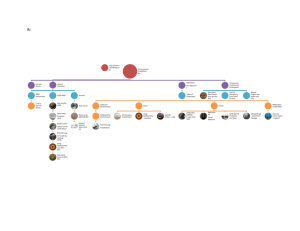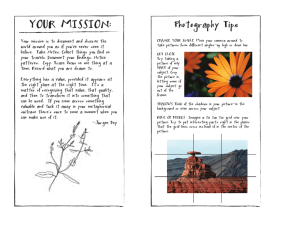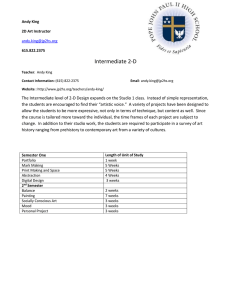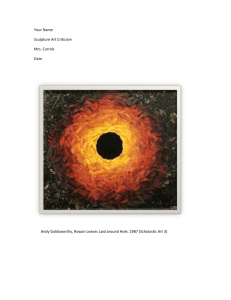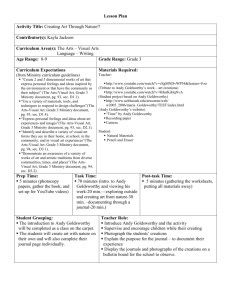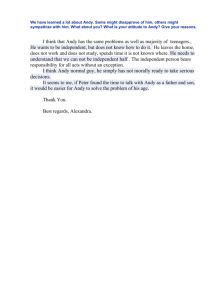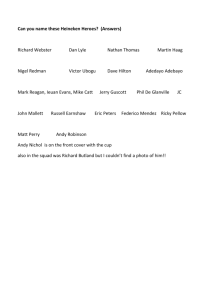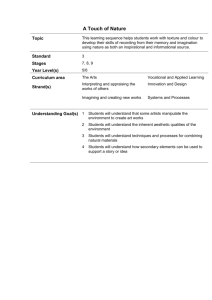Andy Goldsworthy
advertisement
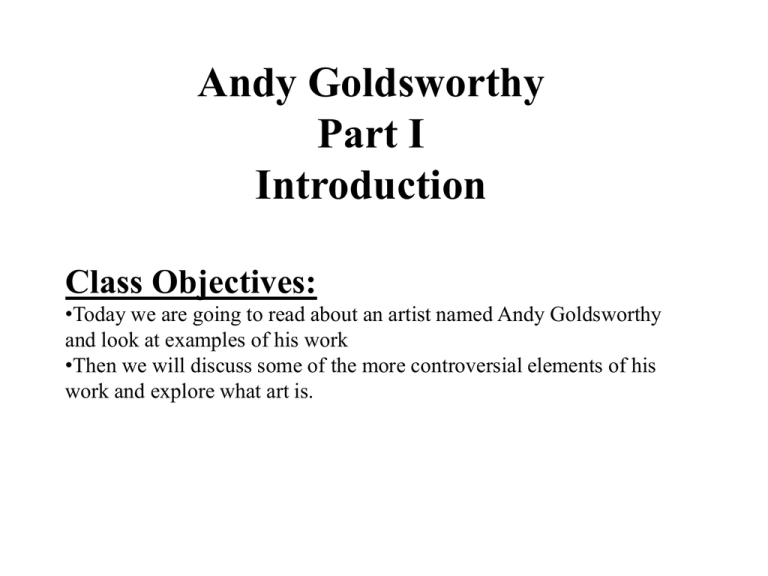
Andy Goldsworthy Part I Introduction Class Objectives: •Today we are going to read about an artist named Andy Goldsworthy and look at examples of his work •Then we will discuss some of the more controversial elements of his work and explore what art is. Andy Goldsworthy Read this Article “35 Who Made a Difference: Andy Goldsworthy Using nature as his canvas, the artist creates works of transcendent beauty” By Arthur Lubow Smithsonian Magazine November 2005 http://www.smithsonianmag.com/arts-culture/35-whomade-a-difference-andy-goldsworthy-114067437/?no-ist Compare and Contrast Andy Goldsworthy, Snow Circles, December 19, 1987, Izumi-Mura, Japan Claude Oscar Monet, Wheatstacks, Snow Effect, Morning, 1891, oil on canvas, Getty Center Why could Any Goldsworthy be described as a modern impressionist? How art these artists capturing the effect of light on snow? According to wikipedia 1. plein air is a French expression which means "in the open air" and is particularly used to describe the act of painting outdoors. Why does Arthur Lubow compare Any Goldsworthy to a plein air landscape painter? Thomas Cole, “Roman Campagna (Ruins of Aqueducts in the Campagna di Roma)", 1843. Thomas Cole is a well known plein air plainter. Andy Goldsworthy’s ”Storm King Wall ”, Storm King Art Center Andy Goldsworthy is considered part of the art movement Land Art Land art Definition From Wikipedia, the free encyclopedia Land art, Earthworks (coined by Robert Smithson), or Earth art is an art movement in which landscape and the work of art are inextricably linked. It is also anart form that is created in nature, using natural materials such as soil, rock (bed rock, boulders, stones), organic media (logs, branches, leaves), and water with introduced materials such as concrete, metal, asphalt, or mineral pigments. Sculptures are not placed in the landscape, rather, the landscape is the means of their creation. Often earth moving equipment is involved. The works frequently exist in the open, located well away from civilization, left to change and erode under natural conditions. Many of the first works, created in the deserts of Nevada, New Mexico, Utah or Arizona were ephemeral in nature and now only exist as video recordings or photographic documents. They also pioneered a category of art called sitespecific sculpture, designed for a particular outdoor location. • Does art need to be made of traditional materials like paint and marble? • Is it still art if it is made from found objects like sticks and stones? • Why do you think Andy Goldsworthy used sticks and stones to make art? • Does Goldsworthy’s choice of materials and setting reflect the Land Art Movement? Why? Andy Goldsworthy’s art is often described as ephemeral because the artwork is not made to last indefinitely. Some of his art only lasts a few moments before melting or drifting away. The only lasting trace of some of his art is in photographs. “Mountain and Coast Autumn into Winter” “Ice spiral” and “Ice Star” •How long should art last? •If only a photograph of an artwork survives, is the original object the artwork or is it the photo? •Is ephemeral or everlasting art work more valuable? •Is any artwork everlasting? Assignment: •For next class dress appropriately to walk outside on the school grounds. •Bring a camera, Smartphone, or other equipment to take digital photography. •Be prepared to make land art. Andy Goldsworthy Part II Creating Site Specific Ephemeral Art Quote by Andy Goldsworthy: “I enjoy the freedom of just using my hands and “found” tools–a sharp stone, the quill of a feather, thorns. I take the opportunities each day offers: if it is snowing, I work with snow, at leaf-fall it will be with leaves; a blown-over tree becomes a source of twigs and branches. I stop at a place or pick up a material because I feel that there is something to be discovered. Here is where I can learn.” Class Objectives •Our class is going to go outside on the school grounds and create a site specific piece of art with only found objects. •We will then use our photography equipment to record our site specific artwork. •We will have two class periods to finish our site specific artwork and document it with photographs. •Be prepared to edit your photos in class during our next assignment . Transfer your digital images onto a jump drive. Andy Goldsworthy Part III Editing Digital Photography Class Objectives •For the next couple class periods we will edit our digital photos from our site specific art project. •We will watch a tutorial video for each step of the process and then apply what we learn to our own photos. • For this assignment you will edit three photos and email them to turnednburned@gmail.com I will then get them printed for our class and we will create an Andy Goldsworthy exhibition at the entrance to our school. Photoshop Tutorials 1. Opening an image in Photoshop Tutorial http://tv.adobe.com/watch/pd-for-educators/opening-an-image-in photoshop/ 2. Cropping Tutorial https://helpx.adobe.com/photoshop/how-to/crop-remove-photo-edges.html use the crop tool to edit out unnecessary imagery and focus the attention on important points. 3. Adjust Color and Tone Tutorial https://helpx.adobe.com/photoshop/how-to/photoshop-improve-tones-levels.html Try adjusting your color levels ( red, blue, green) separately. 4. Getting Your Image Ready to Print Tutorial https://helpx.adobe.com/photoshop/how-to/image-resolution-explained.html Your images should have a resolution of 240 and be no larger than 8x10 inches. Andy Goldsworthy Part IV Dry Mounting and Hanging Prints Class Objectives •Our class will dry mount our site specific ephemeral art prints. •We will install an exhibition at the entrance of our school. Dry Mounting Prints 1. Cut your print to size. Using a piece of newspaper and a sharpie draw a square or rectangle that is the size you want your print to be. Use a square to check that all of your corners are at right angles. Carefully cut out the inside of the square/rectangle from your newsprint so that you create a window. Place your newspaper window on your print. Look for the best view of your print in the window, then lightly mark an L at each corner of your print. Using the matte cutter cut your print to size. 2. Cut your mounting paper the same size as your print or slightly smaller Use your window again to mark the size and scissors to carefully cut the paper. 3. Cut your foam board the same size as your print. Use your window again to mark the size and the matte cutter to cut the foam board. 4. Fuse your print to your foam board. Make a sandwich with your print facing up at the top, the dry mount paper in the middle and your foam board facing glossy side up at the bottom. Use a small amount of masking tape at each corner to hold your sandwich together. then place blotting paper over your sandwich. Hold an iron on low heat for about three minutes in the middle of your sandwich. Be careful not to let the iron heat the tape. Let the sandwich cool and remove the tape. Then with the blotting paper on top of your sandwich continue to iron the rest of your sandwich by holding the iron steady on each area for about three minutes. Sliding the iron back and forth will take longer and could damage your print. 5. Sign, title and center line your print. Please sign, title and date your print. Lightly in pencil draw a center line running horizontally on the back of your print. Art Hanging Arrangements https://woodraildrive.files.wordpress.com/2012/05/picture-2.png Hanging our Prints Now we are going to install an exhibition of our prints at the entrance of our school. 58 inches is an average eye level for most people and artwork is often centered vertically at 58 inches. The artwork is then evenly spaced horizontally between other pieces of art , tall furniture, and openings in a wall for example windows and doors. These are general guide lines art work can also be hung in interesting groups as well. The groups may stack, cluster, or stagger the artwork. A group may have a theme, such as a single artist, dominant color, or a similar mood. Today I want our class to decide how we are going to hang our artwork as a group project. Remember to respect each others opinions by carefully listening and responding politely. Don’t yuck my yum! It’s ok to disagree, but comments should be thoughtful and offer constructive criticism. Comments shouldn’t be bland and thoughtless like that’s wrong or bad or I don’t like it. 1. Caulk Line First we will snap a horizontal caulk line at 58 inches above the floor, and around the perimeter of the room. 2. Quickly Hang Art Work Then we will start placing artwork on the wall with sticky tack. We can use our center line on the back of our prints as a reference to center our artwork on the 58 inches line, but remember we don’t have to center our work that way. Once all of our artwork is on the wall we will begin discussing what works and what we could make better. 3. Rearrange, Discuss, Rearrange We will then continue to rearrange the artwork and discuss the placement until we create a fabulous exhibition! Andy Goldsworthy Part V Aesthetics Discussion Class Objectives •Our class will watch the Andy Goldsworthy documentary “Rivers and Tides” https://www.youtube.com/watch?v=Unv20cR_UTw •Next we will discuss Andy Goldsworthy’s art, our site specific art, and aesthetics. This will conclude our unit on Andy Goldsworthy. Food for Thought •Since we have studied Andy Goldsworthy and made site specific art, how has that affected your views on this kind of art? •What do you think Andy Goldsworthy’s philosophy of art is? Is your philosophy different or similar? •How do you think seeing Andy Goldsworthy’s art in a museum would be different than seeing it in a sculpture park? How would your art change in different settings? Or you classmates artwork? •What did you learn that was interesting or valuable to you during our Andy Goldsworthy Unit? What do you think could have been better?
